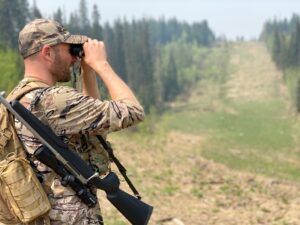Spot and Stalk Bear Hunting Tips
by Kevin Wilson, Professional Outfitter Guide, Alberta Hunting Adventures
Timing was perfect. It was May 17. Brent Foster and I had just finished putting up our wall tent and getting camp ready. With several hours of daylight remaining, we hopped in the truck and headed for an area I had seen lots of bear sign in the past. Only a few miles down the road, we spotted a big bruin contently feeding on a patch of clover. Quickly pulling off into the ditch several hundred yards away, we grabbed our gear and began making our down the open line. Using the rolling topography to conceal our approach, we peaked over a small rise and saw the bear enthusiastically munching on the greens. He  was only 50 yards away and, with the wind in our favor, it would be a chip shot for Brent with his 308 Win. and 150 grain Remington Core-Lokt bullet. A quick shooter, I barely had a chance to say, “there’s your shot”, and he had his rifle shouldered and sent a round on its way! The bear collapsed instantly and it was finished. Many people I know, have expressed a desire to hunt Spring black bear, but they just don’t know where to start. Well, I’m here to tell you that a spot-and-stalk bear hunt is one of the most straightforward and enjoyable outdoor experiences you’ll ever have. Allow me to offer an easy road map to follow for Spring bear hunting success. Required Gear While most hunters are running bear baits, the spot-and-stalk approach can be just as successful and, in my opinion, it is that much more rewarding. Aside from personal and camping equipment, relatively little gear is required to hunt bears. A good binocular, a suitable rifle (ideally a .30 calibre or larger) and ammo (i.e., something like a Core-Lokt, partition, or bonded bullet) or a suitable bow and arrows, a good skinning knife, game bags if you plan on keeping the meat – and you’re mostly set to go. While camouflage clothing is fine, it’s really not necessary. Rain gear is a huge asset as well, because May and June can be very wet months. Time Your Hunt If you plan to do a spot-and-stalk hunt, timing is important. Hunt too early and the grasses will be brown and lifeless. Hunt too late, and foliage is thick and heavy with undergrowth lush across the forest floor. Take care to time your hunt to capitalize on the best quality first green grasses, dandelions and clover on pipeline and powerline Right-of-Ways, cutlines, logged clear-cuts, old two-track trails and even along some roadways. All else being equal, Alberta’s weather generally dictates that the best window for finding a bear feeding out in the open is between May 15 and Jun 10. Indeed, we can get lucky and come across a bear out feeding earlier or later than, but this window can be awesome. Add to this the rut that really heats up from the last week of May throughout the first couple weeks of June, and boars will be on the move looking for sows to breed during this prime time. Find the Food Finding bears in the Spring is as close as one can get to what one might refer to as an exact hunting science. Pinpoint the best nutrient-rich food, and you will eventually find the bears. Dandelions and clover are, by far their preferred source of protein-rich organic forage in the Spring. I’m not just referring to small patches of clover, but the more widespread blankets of heavy dandelions and clover. Bears are abundant throughout Alberta’s boreal forest, eastern slopes and mountain zones. They can be found just about everywhere in this type of habitat. Believe me when I say that Alberta’s bear population is high, and this means that bears will soon find these lush food sources. Locate the Sign Once you’ve discovered the food sources, go for a walk and keep your eyes to the ground. Scour the clover patches for tracks and scat. Tracks – especially in wet soil – will tell you the size of the bears feeding there, and whether there is a single bear or a sow with cubs frequenting that food source. Take note of older scat and fresh scat. If there are varying ages of old and fresh droppings, then chances are one or more bears are routinely dining there. Similarly, take note of clover in which the leaves are chewed off. Clover usually grows back quickly so if its bit off, chances are the bear was there recently. Focus on Prime Times I’ve taken many bears throughout the day, but bears are notably most active in the early hours of the morning and last few hours of the evening. A routine that works well for me as an guide, is taking my clients out from sun-up to about 10:00 am, heading back to camp until about 5:00 pm, then hunting until dark. One of the best windows for seeing bears is usually from 7:00 pm to 10:00 pm. Moving in for the Shot Know that bears are different. While we often feel some urgency to set up and take the shot with deer or elk for instance, black bears are different. Yes, they can change their mind and move into cover fairly quickly but more often than not, they’ll feed in the open for some time. Sneak in slowly and avoid stepping on dry branchs and leaves. Even more importantly, use the wind to your advantage. Taking the Shot As long as the wind is in your favor and they don’t know you’re there, you typically have plenty of time to set up and execute an accurate shot. Bears are heavily motivated by their urge to eat. If they are preoccupied, chances are you’ve got some time. Don’t rush it. Carefully move in as close as you need to for an accurate shot … aim well, and send your trajectory downrange only when you’re ready. With the right bullet, aim square on the centre of the shoulder to break the bear down instantly. A lung shot is good too, but know that bears often don’t bleed much and can be difficult to track. Put the bear down on the spot and you eliminate the tracking job.
was only 50 yards away and, with the wind in our favor, it would be a chip shot for Brent with his 308 Win. and 150 grain Remington Core-Lokt bullet. A quick shooter, I barely had a chance to say, “there’s your shot”, and he had his rifle shouldered and sent a round on its way! The bear collapsed instantly and it was finished. Many people I know, have expressed a desire to hunt Spring black bear, but they just don’t know where to start. Well, I’m here to tell you that a spot-and-stalk bear hunt is one of the most straightforward and enjoyable outdoor experiences you’ll ever have. Allow me to offer an easy road map to follow for Spring bear hunting success. Required Gear While most hunters are running bear baits, the spot-and-stalk approach can be just as successful and, in my opinion, it is that much more rewarding. Aside from personal and camping equipment, relatively little gear is required to hunt bears. A good binocular, a suitable rifle (ideally a .30 calibre or larger) and ammo (i.e., something like a Core-Lokt, partition, or bonded bullet) or a suitable bow and arrows, a good skinning knife, game bags if you plan on keeping the meat – and you’re mostly set to go. While camouflage clothing is fine, it’s really not necessary. Rain gear is a huge asset as well, because May and June can be very wet months. Time Your Hunt If you plan to do a spot-and-stalk hunt, timing is important. Hunt too early and the grasses will be brown and lifeless. Hunt too late, and foliage is thick and heavy with undergrowth lush across the forest floor. Take care to time your hunt to capitalize on the best quality first green grasses, dandelions and clover on pipeline and powerline Right-of-Ways, cutlines, logged clear-cuts, old two-track trails and even along some roadways. All else being equal, Alberta’s weather generally dictates that the best window for finding a bear feeding out in the open is between May 15 and Jun 10. Indeed, we can get lucky and come across a bear out feeding earlier or later than, but this window can be awesome. Add to this the rut that really heats up from the last week of May throughout the first couple weeks of June, and boars will be on the move looking for sows to breed during this prime time. Find the Food Finding bears in the Spring is as close as one can get to what one might refer to as an exact hunting science. Pinpoint the best nutrient-rich food, and you will eventually find the bears. Dandelions and clover are, by far their preferred source of protein-rich organic forage in the Spring. I’m not just referring to small patches of clover, but the more widespread blankets of heavy dandelions and clover. Bears are abundant throughout Alberta’s boreal forest, eastern slopes and mountain zones. They can be found just about everywhere in this type of habitat. Believe me when I say that Alberta’s bear population is high, and this means that bears will soon find these lush food sources. Locate the Sign Once you’ve discovered the food sources, go for a walk and keep your eyes to the ground. Scour the clover patches for tracks and scat. Tracks – especially in wet soil – will tell you the size of the bears feeding there, and whether there is a single bear or a sow with cubs frequenting that food source. Take note of older scat and fresh scat. If there are varying ages of old and fresh droppings, then chances are one or more bears are routinely dining there. Similarly, take note of clover in which the leaves are chewed off. Clover usually grows back quickly so if its bit off, chances are the bear was there recently. Focus on Prime Times I’ve taken many bears throughout the day, but bears are notably most active in the early hours of the morning and last few hours of the evening. A routine that works well for me as an guide, is taking my clients out from sun-up to about 10:00 am, heading back to camp until about 5:00 pm, then hunting until dark. One of the best windows for seeing bears is usually from 7:00 pm to 10:00 pm. Moving in for the Shot Know that bears are different. While we often feel some urgency to set up and take the shot with deer or elk for instance, black bears are different. Yes, they can change their mind and move into cover fairly quickly but more often than not, they’ll feed in the open for some time. Sneak in slowly and avoid stepping on dry branchs and leaves. Even more importantly, use the wind to your advantage. Taking the Shot As long as the wind is in your favor and they don’t know you’re there, you typically have plenty of time to set up and execute an accurate shot. Bears are heavily motivated by their urge to eat. If they are preoccupied, chances are you’ve got some time. Don’t rush it. Carefully move in as close as you need to for an accurate shot … aim well, and send your trajectory downrange only when you’re ready. With the right bullet, aim square on the centre of the shoulder to break the bear down instantly. A lung shot is good too, but know that bears often don’t bleed much and can be difficult to track. Put the bear down on the spot and you eliminate the tracking job.
